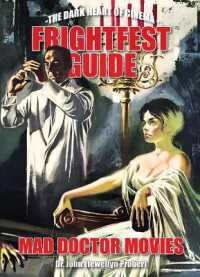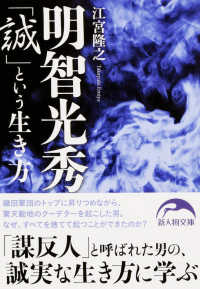- ホーム
- > 洋書
- > 英文書
- > Literary Criticism
Full Description
They were mad, of course. Or evil. Or godless, amoral, arrogant, impersonal, and inhuman. At best, they were well intentioned but blind to the dangers of forces they barely controlled. They were Faust and Frankenstein, Jekyll and Moreau, Caligari and Strangelove-the scientists of film and fiction, cultural archetypes that reflected ancient fears of tampering with the unknown or unleashing the little-understood powers of nature. In From Madman to Crime Fighter, Roslynn D. Haynes analyzes stereotypical characters-including the mad scientist, the cold-blooded pursuer of knowledge, the intrepid pathbreaker, and the bumbling fool-that, from medieval times to the present day, have been used to depict the scientist in Western literature and film. She also describes more realistically drawn scientists, characters who are conscious of their public responsibility to expose dangers from pollution and climate change yet fearful of being accused of lacking evidence.
Drawing on examples from Britain, America, Germany, France, Russia, and elsewhere, Haynes explores the persistent folklore of mad doctors of science and its relation to popular fears of a depersonalized, male-dominated, and socially irresponsible pursuit of knowledge for its own sake. She concludes that today's public response to science and scientists-much of it negative-is best understood by recognizing the importance of such cultural archetypes and their significance as myth. From Madman to Crime Fighter is the most comprehensive study of the image of the scientist in Western literature and film.
Contents
List of Illustrations
Preface
Acknowledgments
Introduction
1. Evil Alchemists and Doctor Faustus
2. Bacon's New Scientists
3. Foolish Virtuosi
4. Newton
5. Arrogant and Godless
6. Inhuman Scientists
7. Frankenstein and the Creature
8. Victorian Scientists
9. The Scientist as Adventurer
10. Efficiency and Power
11. The Scientist as Hero
12. Mad, Bad, and Dangerous to Know
13. The Impersonal Scientist
14. Scientia Gratia Scientiae
15. Robots, Androids, Cyborgs, and Clones
16. Pandora's Box
17. The Scientist as Woman
18. Idealism and Conscience
Conclusion
Appendix
Notes
Bibliography
Index







